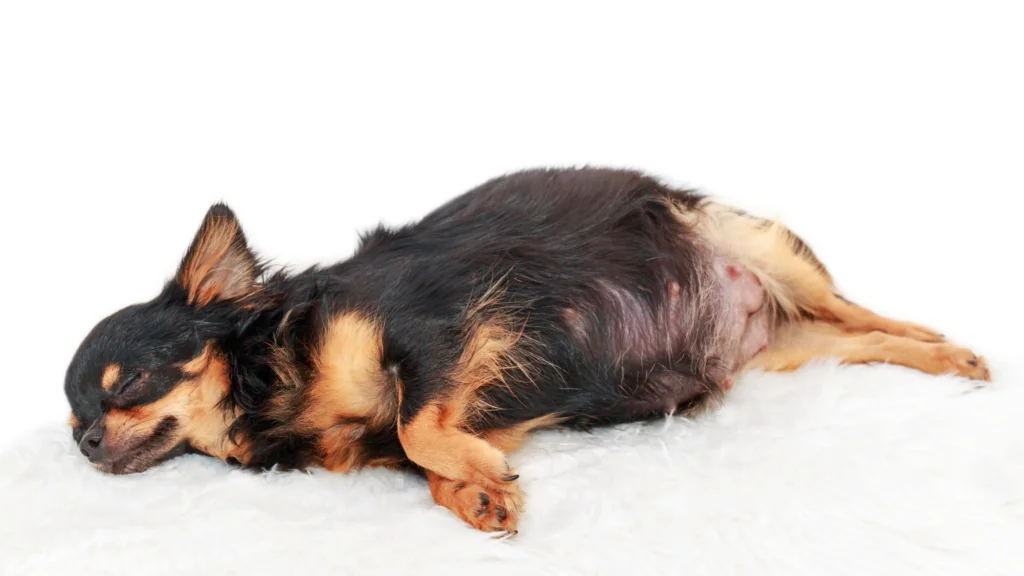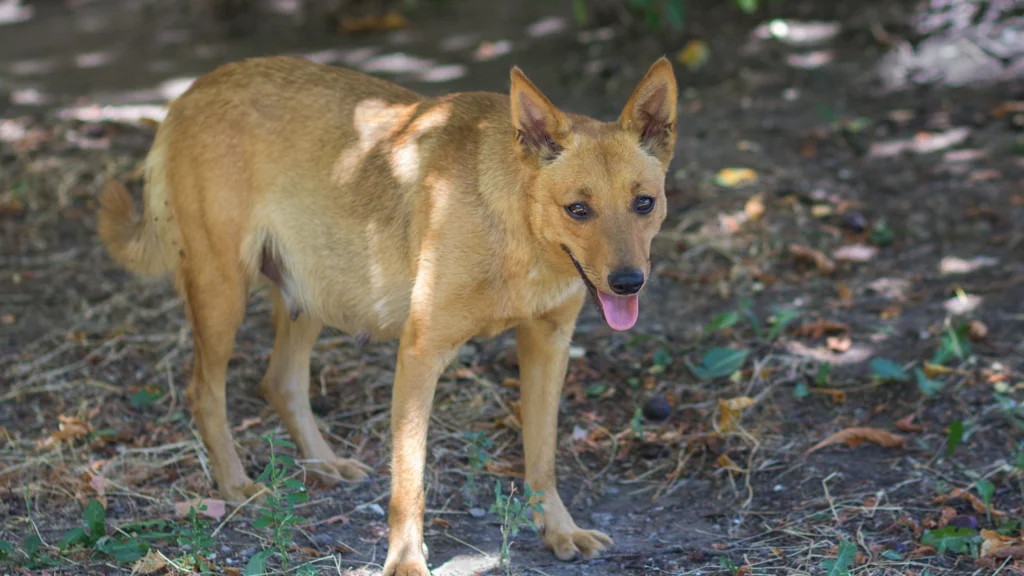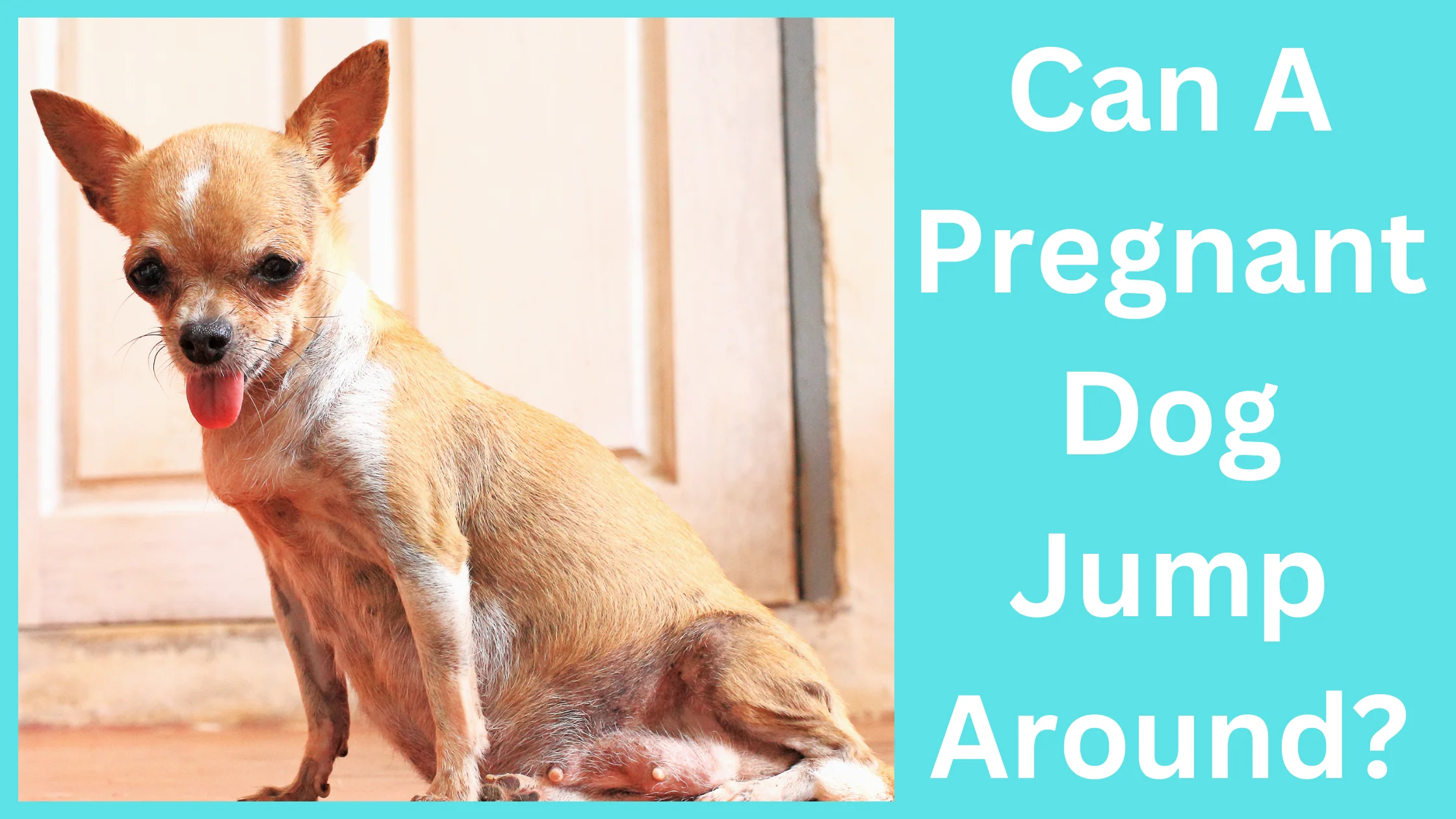Can A Pregnant Dog Jump Around? While it’s natural for dogs to be active, pregnancy can be delicate. If you are a dog owner, you may wonder whether your pregnant dog should be allowed to jump around. This article will discuss everything you need to know about pregnant dogs jumping around, including what to expect and how to keep your dog safe.
Introduction to Pregnancy in Dogs
Pregnancy is a natural and exciting process in the life of a dog. Like humans, dogs undergo a gestational period during which they carry and nurture their unborn puppies.
Pregnancy in dogs typically lasts for around 63 days, during which time the mother dog’s body undergoes significant changes.
These changes can be physical and emotional, and dog owners must understand how to provide their pregnant pets with the best possible care.
This article will explore one specific aspect of pregnancy in dogs – whether pregnant dogs can jump around.
We hope to help dog owners ensure a safe and healthy pregnancy for their furry friends by providing comprehensive information and guidance.
Also Read: Can Takis Kill Dogs? What You Need to Know
Understanding a Dog’s Joints and Muscles
A dog’s musculoskeletal system comprises muscles, bones, joints, ligaments, and tendons. These structures work together to support the dog’s weight, enable movement, and provide stability to the body.
A dog’s joints, mainly, are crucial for mobility and allow for various movements such as running, walking, jumping, and playing.
A dog’s muscles also play a vital role in the movement, providing the power and force required for various activities.
The muscles of the legs, for example, are responsible for propelling the dog forward when running. In contrast, the abdominal muscles help to stabilize the body during activity.
However, a dog’s joints and muscles are not invincible. They can be susceptible to injury and damage, especially during increased physical activity or stress.
For this reason, it is essential to understand the limits of a pregnant dog’s body and avoid activities that may strain its joints and muscles excessively.
When jumping during pregnancy, it is essential to consider the potential risks and take appropriate precautions to ensure the health and safety of the dog and her unborn puppies.
Can A Pregnant Dog Jump Around?
Many pregnant dogs can run and jump during the early stages of pregnancy without any issues.
However, as the pregnancy progresses, it is essential to monitor the dog closely and avoid letting her engage in activities that could put her at risk of injury or harm.
As the dog’s belly grows, she may become more uncomfortable, and activities like jumping and running can strain her joints and muscles unnecessarily.
Additionally, pregnant dogs are at an increased risk of complications like abdominal hernias, pyometra, and miscarriage, so it is essential to consult with a veterinarian before allowing your dog to engage in any physical activity during pregnancy.
The veterinarian can assess the dog’s health and advise you on the best action to keep the mother and her puppies safe.
Risks of Jumping During Pregnancy
While pregnant dogs are generally active and mobile, jumping can pose a risk during pregnancy. The risks of jumping during pregnancy include:
- Injury to the Mother Dog: Jumping can cause physical strain on the joints and muscles of the mother dog, leading to injury and discomfort. This can result in pain, inflammation, and potentially more severe conditions such as joint dislocation or fractures.
- Injury to Unborn Puppies: Jumping can also pose a risk to the developing puppies inside the mother’s womb. The jarring impact of jumping can cause trauma to the developing fetuses, potentially resulting in serious health problems or even miscarriages.
- Complications During Delivery: Jumping during pregnancy can also increase the risk of complications during delivery. Injuries sustained during jumping can make it more difficult for the mother to give birth naturally, potentially leading to the need for a cesarean section.
While jumping is generally discouraged during pregnancy, every dog is unique, and some may be more physically capable than others.
It is essential to monitor your pregnant dog’s activity levels closely and consult a veterinarian to determine what types of physical activity are appropriate for your dog’s specific condition.
By taking appropriate precautions, you can help to minimize the risks of jumping and promote a safe and healthy pregnancy for your furry friend.
Also Read: Can dogs eat Honey Buns? Is Honey toxic for dogs
Safe Ways for Pregnant Dogs to Stay Active
While jumping and other high-impact activities should be avoided during pregnancy, there are still many safe and healthy ways for pregnant dogs to stay active. Here are some suggestions:
- Walking: Regular walks are an excellent way for pregnant dogs to stay active while minimizing the risk of injury. Walking provides a low-impact exercise that can help maintain cardiovascular health, improve muscle tone, and stimulate mental and physical activity.
- Swimming: Swimming is an excellent way for pregnant dogs to stay active without putting any strain on their joints or muscles. Water provides a low-impact environment that can help relieve body pressure while providing an excellent form of exercise.
- Gentle Playtime: While high-impact activities such as jumping should be avoided, pregnant dogs can still enjoy gentle playtime. Playing with soft toys or engaging in gentle games such as fetch or tug-of-war can provide mental and physical stimulation without causing any harm.
- Controlled Exercise: Controlled exercise can effectively provide pregnant dogs with safe and healthy physical activity. This may include activities such as agility training, obedience training, or other controlled exercise that can help improve coordination, balance, and strength.
It is essential to monitor your pregnant dog’s activity levels and adjust the intensity and duration of exercise as needed to ensure their comfort and safety.
Consult with your veterinarian to determine what types of activities are appropriate for your dog’s specific condition, and make sure to provide plenty of opportunities for rest and relaxation.
How much exercise is too much for a pregnant dog?

While exercise is vital for pregnant dogs, it is essential to avoid over-exertion. Too much exercise can lead to problems such as dehydration, overheating, and even miscarriage.
It is best to keep your dog’s exercise moderate during pregnancy and consult your veterinarian regarding your dog’s specific exercise needs.
What are the signs that a pregnant dog needs to rest?
As your dog’s due date approaches, she will start to exhibit signs of nesting, such as looking for a place to have her puppies.
She may also gain weight, and her mammary glands will swell in preparation for lactation. These are all typical signs that your dog is getting ready to give birth.
However, suppose your dog is panting excessively, having trouble walking, refusing to eat or drink, or exhibiting other signs of exhaustion or distress.
In that case, taking her to the vet is crucial to ensure she is healthy and not in danger.
Tips for Managing a Pregnant Dog’s Activity
Managing a pregnant dog’s activity is essential to ensuring a safe and healthy pregnancy. Here are some tips to help manage your pregnant dog’s activity:
- Consult with a Veterinarian: Before starting any exercise program or changing your dog’s activity level, consult a veterinarian. They can assess your dog’s overall health and recommend safe and appropriate physical activity.
- Monitor Activity Levels: Keep track of your dog’s activity level and adjust accordingly. Suppose your dog shows signs of fatigue or discomfort. In that case, it may be time to reduce the intensity or duration of exercise.
- Provide Adequate Rest: Make sure your pregnant dog has plenty of opportunities for rest and relaxation. Provide a comfortable bed or quiet space where they can rest undisturbed.
- Avoid High-impact Activities: High-impact activities such as jumping or running should be avoided during pregnancy. Instead, focus on low-impact activities such as walking, swimming, and gentle play.
- Adjust Nutrition: Pregnant dogs require additional nutrition to support the growth and development of their puppies. Talk to your veterinarian about adjusting your dog’s diet to ensure they receive nutrients.
- Monitor Weight: Monitoring your pregnant dog’s weight is essential to ensure a healthy pregnancy. Excessive weight gain can strain joints and increase the risk of complications during delivery.
By following these tips and closely monitoring your pregnant dog’s activity levels, you can help ensure a safe and healthy pregnancy for your furry friend.
What a pregnant dog should not do?

There are several things that pregnant dogs should not do to ensure the safety and health of both the mother and her puppies:
- Pregnant dogs should not be spayed: While spaying is a common practice to prevent unwanted litters, it is dangerous for pregnant dogs. The surgery puts the mother at risk for infection, bleeding, and death. It also increases the risk of stillbirth and early neonatal death.
- Pregnant dogs should not be given vaccinations: Vaccinations are designed to stimulate the immune system, but a pregnant dog’s immune system is already suppressed. This can lead to the development of autoimmune diseases in the puppies.
- Pregnant dogs should not be fed a commercial diet: Commercial diets may lack the necessary nutrients for a pregnant dog and her puppies, leading to malnutrition.
- Pregnant dogs should not be exercised excessively: While exercise is essential for a pregnant dog, too much exercise can be dangerous. It can lead to dehydration, overheating, and even abortion.
- Pregnant dogs should not be left alone for long periods: A pregnant dog must be with her owner or a trusted caretaker. She may need assistance with birthing, and she may also experience anxiety or depression during pregnancy.
It is essential to provide proper care and attention to pregnant dogs to ensure the health and safety of both the mother and her puppies.
Consulting with a veterinarian is also recommended to address any concerns and to ensure a healthy pregnancy.
Can a pregnant dog climb stairs?
Yes, a pregnant dog can climb stairs, but it’s essential to limit the amount of stair climbing as the pregnancy progresses.
It’s best to avoid high-impact activities, like jumping or running up and down the stairs. This is because the weight and size of the growing puppies can put pressure on the mother’s joints and ligaments, increasing the risk of injury or complications.
As a general rule, it’s best to limit stair climbing to a minimum and provide a comfortable and easily accessible resting area for the pregnant dog.
Additionally, it’s always a good idea to consult a veterinarian regarding any specific concerns or recommendations for your dog’s pregnancy.
When should you stop walking a pregnant dog?
As the pregnancy progresses, monitoring the pregnant dog’s behavior and adjusting its exercise routine is essential.
Generally, a pregnant dog can continue their regular exercise routine, such as walking, until around the sixth week of pregnancy.
At this point, it’s recommended to gradually reduce their exercise to prevent any complications during delivery.
It’s important to note that each dog’s pregnancy is unique, and it’s always best to consult a veterinarian to determine the appropriate exercise routine for the pregnant dog based on their needs and health status.
Suppose the dog shows any signs of discomfort or exhaustion during exercise. In that case, it’s best to stop and rest and seek advice from a veterinarian if necessary.
Consult Your Vet
Consulting with a veterinarian is essential when managing a pregnant dog’s activity. A veterinarian can assess your dog’s overall health and recommend safe and appropriate physical activity.
They can also monitor your dog’s pregnancy, provide nutritional guidance, and detect and address any potential health concerns or complications that may arise.
It is essential to consult with your veterinarian throughout your dog’s pregnancy, from the early stages of gestation to the delivery of the puppies.
This can help ensure your dog receives the care and attention she needs to stay healthy and safe throughout the process.
In addition to monitoring your dog’s physical activity, a veterinarian can also provide guidance on other aspects of pregnancy care, such as nutrition, vaccinations, and parasite prevention.
By working closely with your veterinarian, you can help to ensure a safe and healthy pregnancy for your furry friend and her puppies.
Remember, every dog is unique; what works for one dog may not work for another. Consulting with a veterinarian can provide individualized guidance and help you make informed decisions about managing your pregnant dog’s activity and overall care.
Conclusion
In conclusion, managing a pregnant dog’s activity is essential to ensuring a safe and healthy pregnancy.
While high-impact activities such as jumping should be avoided, there are still many safe and healthy ways for pregnant dogs to stay active, including walking, swimming, gentle play, and controlled exercise.
It is essential to monitor your pregnant dog’s activity levels and adjust as needed to ensure their comfort and safety.
Consulting with a veterinarian is essential when it comes to managing a pregnant dog’s activity, as they can provide recommendations for safe and appropriate physical activity, monitor your dog’s pregnancy, and address any potential health concerns or complications.
By following these tips and working closely with your veterinarian, you can help to ensure a safe and healthy pregnancy for your furry friend and her puppies.
